python mathematical modeling example analysis
SciPy learning
''' SciPy 包含的模块有最优化、线性代数、积分、插值、特殊函数、快速傅里叶变换、 信号处理和图像处理、常微分方程求解和其他科学与工程中常用的计算。 ''' # 安装scipy库: # SciPy终端安装命令:pip install SciPy # https://www.runoob.com/w3cnote/python-pip-install-usage.html Python pip 安装与使用 # 查看scipy版本: import scipy print(scipy.__version__) # SciPy模块功能表 ''' 模块 功能 scipy.cluster 聚类分析等 scipy.constants 物理和数学函数 scipy.fftpack 傅里叶变换 scipy.integrate 积分 scipy.interpolate 插值 scipy.io 数据输入和输出 scipy.linalg 线性代数 scipy.ndimage n维图像 scipy.odr 正交距离回归 scipy.optimize 优化 scipy.signal 信号处理 scipy.sparse 稀疏矩阵 scipy.spatial 空间数据结构和算法 scipy.special 特殊函数 scipy.stats 统计 ''' # 使用 dir() 函数来查看 constants 模块包含的常量: from scipy import constants print(dir(constants)) ''' 单位类型 常量模块包含以下几种单位: 公制单位 二进制,以字节为单位 质量单位 角度换算 时间单位 长度单位 压强单位 体积单位 速度单位 温度单位 能量单位 功率单位 力学单位 ''' print() # SciPy 常量模块: # constants 是 scipy 的常量模块 from scipy import constants # 查看一英亩等于多少平方米: print(constants.acre) # 输出 4046.8564223999992 # SciPy 常量模块 constants 提供了许多内置的数学常数 # 圆周率: pi # 黄金比例: golden from scipy import constants print(constants.pi) # 输出 3.141592653589793 【圆周率】 print(constants.golden) # 输出 1.618033988749895 【黄金比例】
SciPy basic operations
1-Solving nonlinear equations (group)
1-1

The solution code is as follows:
# scipy.optimize模块的fsolve和root可求非线性方程(组)的解
# 格式:
from scipy.optimize import fsolve
from scipy.optimize import root
# fsolve或root求解非线性方程组时,先把非线性方程组写成 F(x)=0 这样的形式【x:向量;F(x):向量函数】
fx = lambda x: x**980-5.01*x**979-3.388*x**977\
+7.398*x**978-x**3+5.01*x**2-7.398*x+3.388
x1 = fsolve(fx, 1.5, maxfev=420) # 函数调用420次【调用小了,会报警告】
x2 = root(fx, 1.5)
print(x1) # 相当于答案
print()
print(x2) # 相当于解题过程The results of running x1 and x2 are as follows:
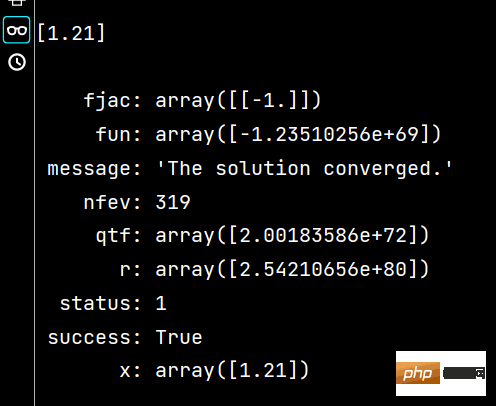
1-2

The solution code is as follows:
from scipy.optimize import fsolve, root fs2 = lambda s: [s[0]**2+s[1]**2-1, s[0]-s[1]] s1 = fsolve(fs2, [1, 1]) print() s2 = root(fs2, [1, 1]) print(s1) # 输出 [0.70710678 0.70710678] print() print(s2)
The effect of running s2 is as follows:
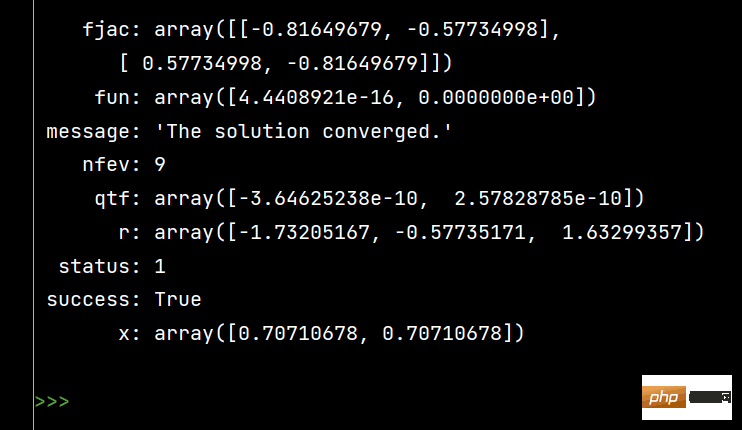
2-Integral
The scipy.integrate module provides a variety of integration modes.
Integrals are mainly divided into the following two categories:
Numerical integration of a given function
For numerical integration of given discrete points, the function has trapz
Title:

'''
函数 说明
quad(func, a, b, args) 计算一重数值积分
dblquad(func, a, b, gfun, hfun, args) 计算二重数值积分
tplquad(func, a, b, gfun, hfun, qfun, rfun) 计算三重数值积分
nquad(func, ranges, args) 计算多变量积分
'''
from scipy.integrate import quad
def func(x, a, b):
return a*x**2+b*x
z1 = quad(func, 0, 1, args=(2, 1))
z2 = quad(func, 0, 1, args=(2, 10))
print(z1) # 输出 (1.1666666666666665, 1.2952601953960159e-14)
print(z2) # 输出 (5.666666666666667, 6.291263806209221e-14)
# 注:输出的后一个值为积分值的绝对误差3-Least squares solution

# 最小二乘解 # scipy.optimize 模块求非线性方程组最小二乘解格式: ''' from scipy.optimize import least_squares least_squares(fun, x0) 注:用到loadtxt需自行准备好文件【准备文件】 ''' from scipy.optimize import least_squares import numpy as np s = np.loadtxt('data.txt') x0 = s[0] y0 = s[1] d = s[2] fs = lambda x: np.sqrt((x0-s[0])**2+(y0-s[1])**2-d) xc = least_squares(fs, np.random.rand(2)) print(xc) print() print(xc.s)
4-Maximum modular eigenvalue and corresponding eigenvector
Question:

# 4-最大模特征值及对应的特征向量
# 题目描述:求下列矩阵的最大模特征值及对应的特征向量:
from scipy.sparse.linalg import eigs
import numpy as np
m = np.array([
[1, 2, 3],
[2, 1, 3],
[3, 3, 6]
], dtype=float)
a, b = np.linalg.eig(m)
c, d = eigs(m, 1)
print('最大模特征值为:', c) # 输出 最大模特征值为: [9.+0.j]
print('对应的特征向量:\n', d)The running results are as follows:
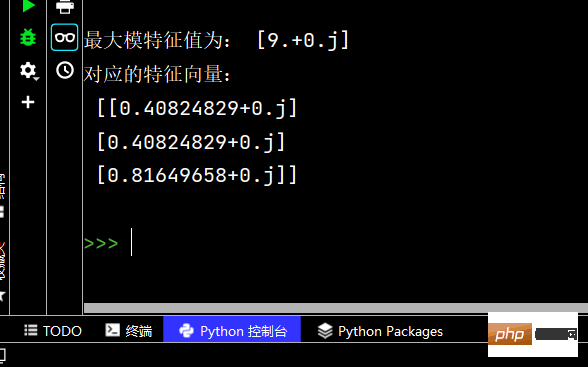
Numpy Learning (continued)
# NumPy 广播(Broadcast)
# 广播是 numpy 对不同形状的数组进行数值计算的方式, 对数组的算术运算通常在相应的元素上进行。
# 如果两个数组 a 和 b 形状相同,即满足 a.shape == b.shape,那么 a*b 的结果就是 a 与 b 数组对应位相乘。
# 这要求维数相同,且各维度的长度相同。
'''
对两个数组,分别比较他们的每一个维度(若其中一个数组没有当前维度则忽略),满足:
数组拥有相同形状。
当前维度的值相等。
当前维度的值有一个是 1。
若条件不满足,抛出 "ValueError: frames are not aligned" 异常
'''
import numpy as np
a = np.array([3, 6, 9])
b = np.array([2, 4, 6])
c = a * b
print(c) # 输出 [ 6 24 54]
# 若形状不同时,numpy 将自动触发广播机制
import numpy as np
x = np.array([
[4, 2, 5],
[5, 2, 0],
[2, 6, 1],
[1, 4, 5]
])
y = np.array([3, 1, 2])
print(x+y)
yy = np.tile(y, (4, 1)) # 重复b的各个维度
print(x+yy)1 Numpy mathematical function
1-1 Trigonometric function
# NumPy 数学函数 # NumPy 包含大量的各种数学运算的函数,包括三角函数,算术运算的函数,复数处理函数等。 # 1-三角函数 # NumPy 提供了标准的三角函数:sin()、cos()、tan()。 import numpy as np lxw = np.array([0, 30, 45, 60, 90]) # sin() zx = np.sin(lxw*np.pi/180) print(zx) # 计算角度的反正弦【单位:弧度】 fzx = np.arcsin(zx) print(fzx) # 检查结果【通过转化为角度制】 jg = np.degrees(fzx) print(jg) # 输出 [ 0. 30. 45. 60. 90.] # cos() yx = np.cos(lxw*np.pi/180) print(yx) # 反余弦 fyx = np.arccos(yx) print(fyx) # 检查结果: jg2 = np.degrees(fyx) print(jg2) # 输出 [ 0. 30. 45. 60. 90.] # tan() zq = np.tan(lxw*np.pi/180) print(zq) # 反正切 fzq = np.arctan(zq) print(fzq) # 检查结果: jg3 = np.degrees(fzq) print(jg3) # 输出 [ 0. 30. 45. 60. 90.]
2-Rounding function
2-1 numpy.around()
# 2-舍入函数 # 2-1 numpy.around() ''' numpy.around() 函数返回指定数字的四舍五入值。 格式: numpy.around(a,decimals) 参数说明: a: 数组 decimals: 舍入的小数位数。 默认值为0。 如果为负,整数将四舍五入到小数点左侧的位置 ''' import numpy as np bl = np.array([15.222, 22.6555, 13.71111]) print(np.around(bl)) # 输出 [15. 23. 14.] print(np.around(bl, 2)) # 输出 [15.22 22.66 13.71] print(np.around(bl, -1)) # 输出 [20. 20. 10.]
2-2 numpy.floor()
# 2-2 numpy.floor() # numpy.floor() 返回小于或者等于指定表达式的最大整数,即向下取整 import numpy as np xx = np.array([23.3, 13.43, 2.9]) print(np.floor(xx)) # 输出 [23. 13. 2.]
2-3 numpy.ceil()
# 2-3 numpy.ceil() # numpy.ceil() 返回大于或者等于指定表达式的最小整数,即向上取整 import numpy as np xs = np.array([23.1, 23.5, 54.9]) print(np.ceil(xs)) # 输出 [24. 24. 55.]
3 Numpy arithmetic functions
NumPy arithmetic functions include simple addition Subtraction, multiplication and division: add(), subtract(), multiply() and divide()
- ##Reciprocal: reciprocal()
- Power: power()
- Remainder: mod() | remainder()
Note: The arrays must have the same The shape or conforms to the array broadcasting rules
The relevant code is as follows:
import numpy as np sz = np.arange(9, dtype=np.float_).reshape(3, 3) sz2 = np.array([5, 2, 1]) # 注:如果相除,这里是被除数的话,里面不能有0 # 数组相加 xj = np.add(sz, sz2) print(xj) # 数组相减 xj2 = np.subtract(sz, sz2) print(xj2) # 数组相乘 xc = np.multiply(sz, sz2) print(xc) # 数组相除 xc2 = np.divide(sz, sz2) print(xc2) print() # numpy.power() # numpy.power() 函数将第一个输入数组中的元素作为底数,计算它与第二个输入数组中相应元素的幂 import numpy as np m = np.array([1, 4, 8]) # 数组1 mc = np.power(m, 3) # 数组1所有元素对应的3次方 print(mc) # 输出 [ 1 64 512] m2 = np.array([1, 2, 3]) # 数组2 mc2 = np.power(m, m2) # 数组1作为底数,数组2作为幂 print(mc2) # 输出 [ 1 16 512] print() # numpy.mod() # numpy.mod() 计算输入数组中相应元素的相除后的余数 # 函数 numpy.remainder() 也产生相同的结果 import numpy as np sz1 = np.array([23, 45, 67]) sz2 = np.array([2, 3, 5]) print(np.mod(sz1, sz2)) # 输出 [1 0 2] print(np.remainder(sz1, sz2)) # 输出 [1 0 2]
#SettingWithCopyWarning of pandas
# pandas的SettingWithCopyWarning报警复现、原因、解决方案 # 读取数据 import pandas as pd df = pd.read_csv('nba.csv') print(df.head()) # 核心解决问题:pandas的dataframe的修改写操作,只允许在源dataframe上进行,一步到位 # 解决方法(两种): ''' 1-将get+set的两步操作,改成set的一步操作 2-若须处理筛选数据做后续的处理分析,使用copy复制dataframe ''' # pandas不允许先筛选子dataframe,在进行修改写入
Please prepare the csv file first】
Series sorting:
# Pandas 数据排序
'''
Series的排序:
Series.sort_values(ascending=True, inplace=False)
参数说明:
· ascending: 默认为True升序排序,False为False
· inplace: 是否修改原始Series
DataFrame的排序:
DataFrame.sort_values(by, ascending=True, inplace=False)
参数说明:
· by:字符串或者List<字符串>,单列排序或者多列排序
· ascending: bool或者List,升序还是降序
· inplace: 是否修改原始DataFrame
'''
# Series的排序:
import pandas as pd
df = pd.read_csv('nba.csv')
print(df.head()) # 输出前五行
print(df['Weight'].sort_values()) # 升序排序
print(df['Weight'].sort_values(ascending=False)) # 降序排序The running results are as follows:

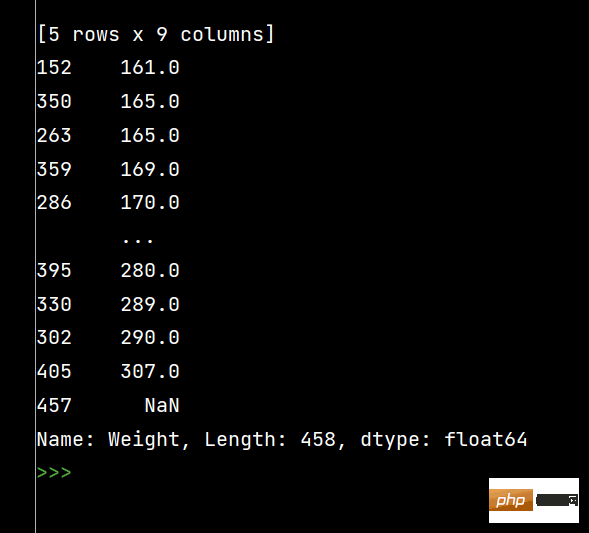
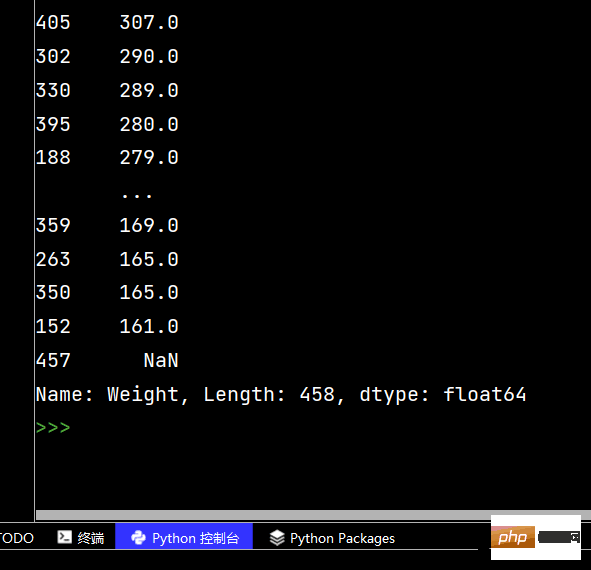 ##DataFrame sorting
##DataFrame sorting
# DataFrame的排序 # 单列排序: print(df.sort_values(by='Weight'))
##
print(df.sort_values(by="Weight", ascending=False)) # 降序排序
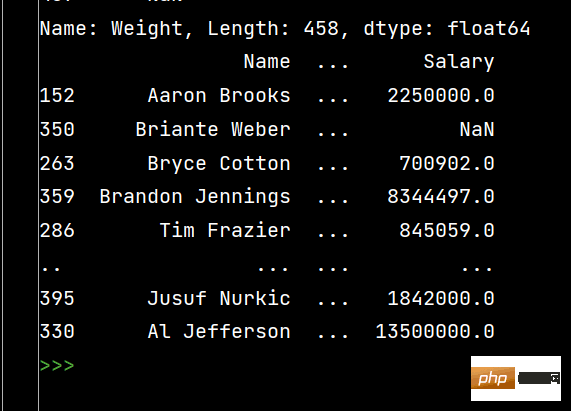
# 多列排序: print(df.sort_values(by=['Age', 'Weight']))
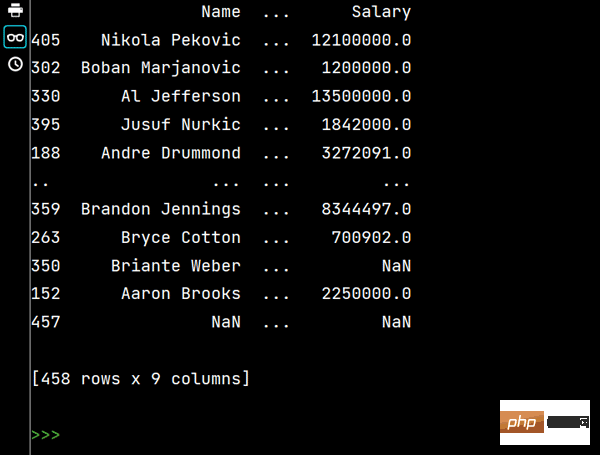
# 两个字段都是降序排序 print(df.sort_values(by=['Age', 'Weight'], ascending=False))
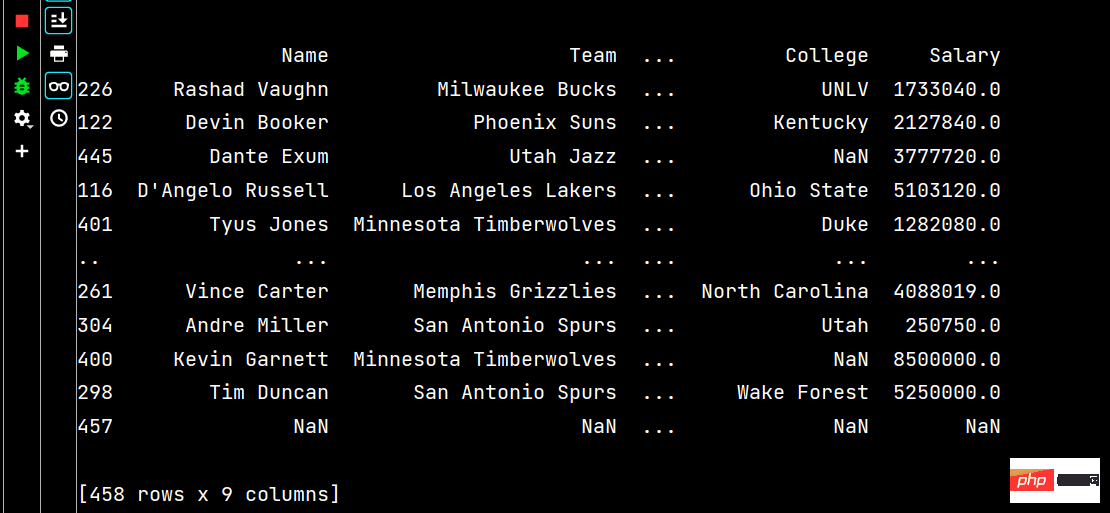
# 分别指定升序还是降序 print(df.sort_values(by=['Age', 'Weight'], ascending=[False, True]))

Pandas string processing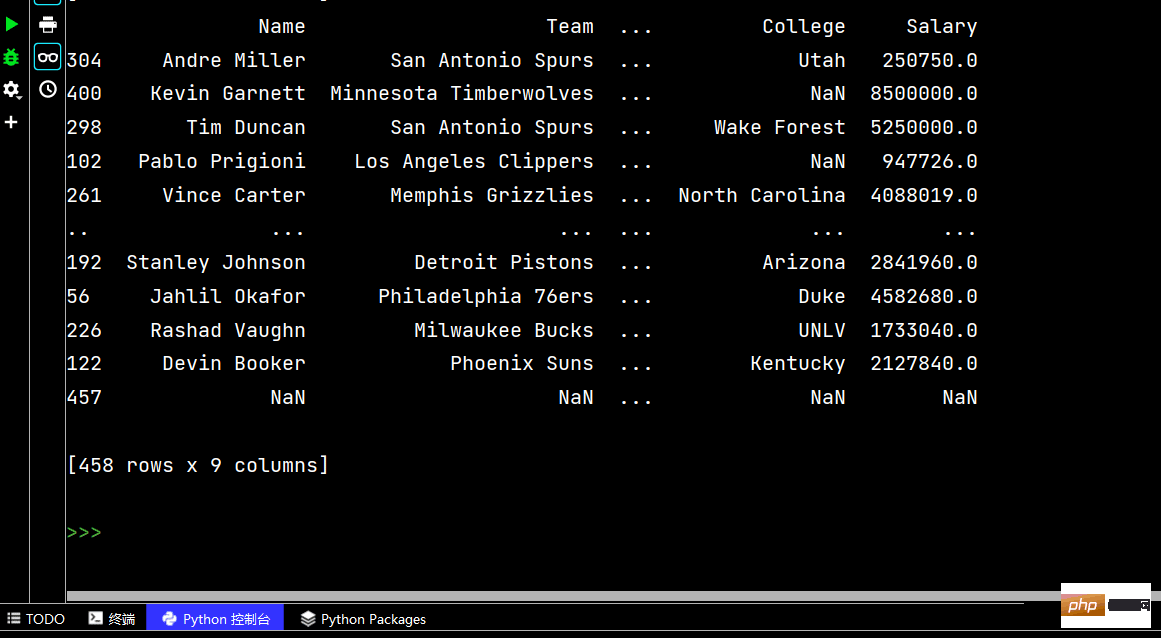
df['lrl'].str.replace("%", "").astype("int32")Copy after login# Pandas字符串处理:
'''
1-使用方法:先获取Series的属性,然后再属性上调用函数
2-只能在字符串列上使用,不能再数字列上使用
3-DataFrame没有str属性和使用
4-Series.str并不是原生Python字符串,它是封装的一套方法
'''
# 获取Series的属性
# print(df['Salary'].str) # 报错【示范】
# AttributeError: Can only use .str accessor with string values!
# AttributeError:只能使用。带字符串值的str访问器!
# 一定得是字符串列
print(df['College'].str)
# 运行结果为: <pandas.core.strings.accessor.StringMethods object at 0x00000204444EBC48>
# 判断是不是数字列
print(df['College'].str.isnumeric())
# print(df['College'].len) # 报错【示范】
# AttributeError: 'Series' object has no attribute 'len'
# AttributeError:“Series”对象没有属性“len”
Copy after login
df['lrl'].str.replace("%", "").astype("int32")# Pandas字符串处理: ''' 1-使用方法:先获取Series的属性,然后再属性上调用函数 2-只能在字符串列上使用,不能再数字列上使用 3-DataFrame没有str属性和使用 4-Series.str并不是原生Python字符串,它是封装的一套方法 ''' # 获取Series的属性 # print(df['Salary'].str) # 报错【示范】 # AttributeError: Can only use .str accessor with string values! # AttributeError:只能使用。带字符串值的str访问器! # 一定得是字符串列 print(df['College'].str) # 运行结果为: <pandas.core.strings.accessor.StringMethods object at 0x00000204444EBC48> # 判断是不是数字列 print(df['College'].str.isnumeric()) # print(df['College'].len) # 报错【示范】 # AttributeError: 'Series' object has no attribute 'len' # AttributeError:“Series”对象没有属性“len”
# 使用str的startswith、contains等得到bool的Series可以做条件查询
tj = df['Height'].str.startswith("6-2")
print(tj)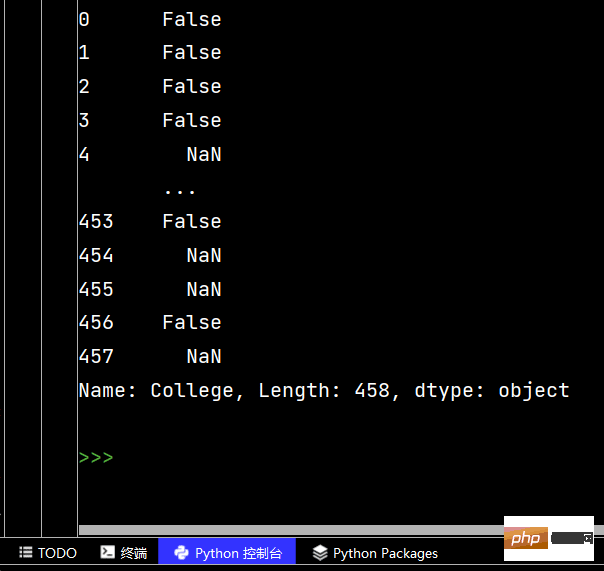
# 去掉Height中间的“-”
print(df['Height'].str.replace("-", ""))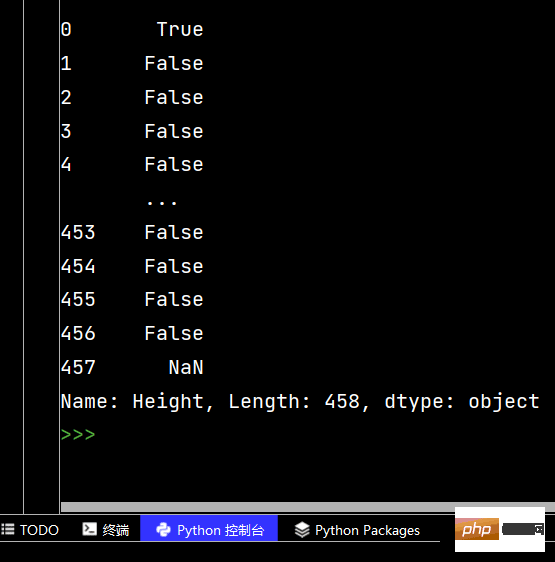
# 取第一位数
print(df['Height'].str.replace("-", "").str.slice(0, 1))
# 同上
print(df['Height'].str.replace("-", "").str[0:1])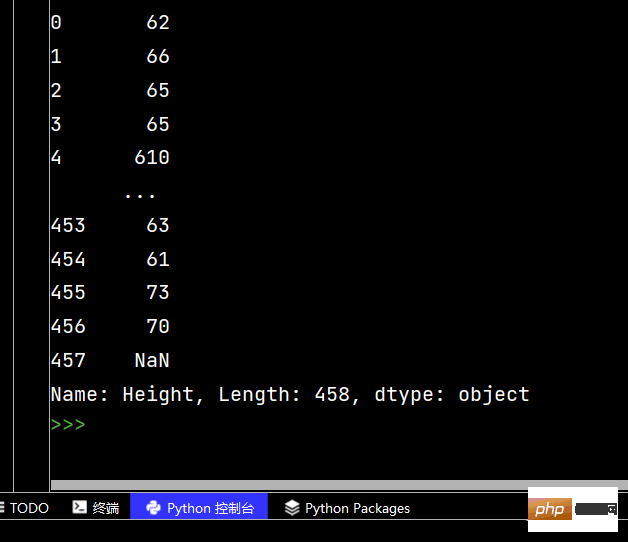
The above is the detailed content of python mathematical modeling example analysis. For more information, please follow other related articles on the PHP Chinese website!

Hot AI Tools

Undresser.AI Undress
AI-powered app for creating realistic nude photos

AI Clothes Remover
Online AI tool for removing clothes from photos.

Undress AI Tool
Undress images for free

Clothoff.io
AI clothes remover

AI Hentai Generator
Generate AI Hentai for free.

Hot Article

Hot Tools

Notepad++7.3.1
Easy-to-use and free code editor

SublimeText3 Chinese version
Chinese version, very easy to use

Zend Studio 13.0.1
Powerful PHP integrated development environment

Dreamweaver CS6
Visual web development tools

SublimeText3 Mac version
God-level code editing software (SublimeText3)

Hot Topics
 1378
1378
 52
52
 Python: Exploring Its Primary Applications
Apr 10, 2025 am 09:41 AM
Python: Exploring Its Primary Applications
Apr 10, 2025 am 09:41 AM
Python is widely used in the fields of web development, data science, machine learning, automation and scripting. 1) In web development, Django and Flask frameworks simplify the development process. 2) In the fields of data science and machine learning, NumPy, Pandas, Scikit-learn and TensorFlow libraries provide strong support. 3) In terms of automation and scripting, Python is suitable for tasks such as automated testing and system management.
 The 2-Hour Python Plan: A Realistic Approach
Apr 11, 2025 am 12:04 AM
The 2-Hour Python Plan: A Realistic Approach
Apr 11, 2025 am 12:04 AM
You can learn basic programming concepts and skills of Python within 2 hours. 1. Learn variables and data types, 2. Master control flow (conditional statements and loops), 3. Understand the definition and use of functions, 4. Quickly get started with Python programming through simple examples and code snippets.
 Navicat's method to view MongoDB database password
Apr 08, 2025 pm 09:39 PM
Navicat's method to view MongoDB database password
Apr 08, 2025 pm 09:39 PM
It is impossible to view MongoDB password directly through Navicat because it is stored as hash values. How to retrieve lost passwords: 1. Reset passwords; 2. Check configuration files (may contain hash values); 3. Check codes (may hardcode passwords).
 How to use AWS Glue crawler with Amazon Athena
Apr 09, 2025 pm 03:09 PM
How to use AWS Glue crawler with Amazon Athena
Apr 09, 2025 pm 03:09 PM
As a data professional, you need to process large amounts of data from various sources. This can pose challenges to data management and analysis. Fortunately, two AWS services can help: AWS Glue and Amazon Athena.
 How to start the server with redis
Apr 10, 2025 pm 08:12 PM
How to start the server with redis
Apr 10, 2025 pm 08:12 PM
The steps to start a Redis server include: Install Redis according to the operating system. Start the Redis service via redis-server (Linux/macOS) or redis-server.exe (Windows). Use the redis-cli ping (Linux/macOS) or redis-cli.exe ping (Windows) command to check the service status. Use a Redis client, such as redis-cli, Python, or Node.js, to access the server.
 How to read redis queue
Apr 10, 2025 pm 10:12 PM
How to read redis queue
Apr 10, 2025 pm 10:12 PM
To read a queue from Redis, you need to get the queue name, read the elements using the LPOP command, and process the empty queue. The specific steps are as follows: Get the queue name: name it with the prefix of "queue:" such as "queue:my-queue". Use the LPOP command: Eject the element from the head of the queue and return its value, such as LPOP queue:my-queue. Processing empty queues: If the queue is empty, LPOP returns nil, and you can check whether the queue exists before reading the element.
 How to view server version of Redis
Apr 10, 2025 pm 01:27 PM
How to view server version of Redis
Apr 10, 2025 pm 01:27 PM
Question: How to view the Redis server version? Use the command line tool redis-cli --version to view the version of the connected server. Use the INFO server command to view the server's internal version and need to parse and return information. In a cluster environment, check the version consistency of each node and can be automatically checked using scripts. Use scripts to automate viewing versions, such as connecting with Python scripts and printing version information.
 How secure is Navicat's password?
Apr 08, 2025 pm 09:24 PM
How secure is Navicat's password?
Apr 08, 2025 pm 09:24 PM
Navicat's password security relies on the combination of symmetric encryption, password strength and security measures. Specific measures include: using SSL connections (provided that the database server supports and correctly configures the certificate), regularly updating Navicat, using more secure methods (such as SSH tunnels), restricting access rights, and most importantly, never record passwords.




